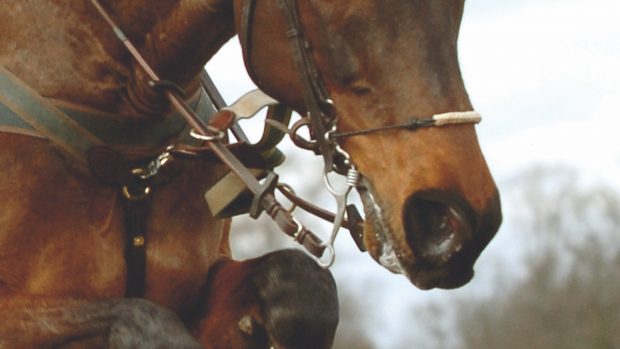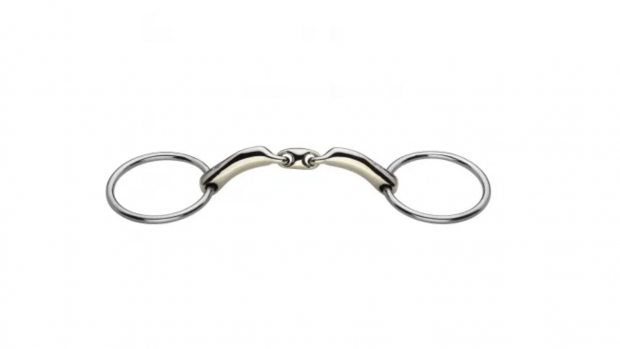If you’re considering whether a Waterford running gag bit would suit your horse, you should start by first selecting the most appropriate mouthpiece for your horse’s individual mouth type and conformation, the discipline you are taking part in, and the level of both your horse’s training and the skillset of the rider.
What is a Waterford running gag?
A Waterford running gag mouthpiece can be found across a wide range of bits including snaffles, pelhams, running gags and leaver bits. Each of these groups will have different actions and a wide range of ring – or cheek – designs. Seek help and guidance from a professional bit and bridle fitter of you are unsure and require further help.
“The Waterford gag bit’s cheeks have a hole at the top and bottom through which a specially adapted bridle cheekpiece runs,” explains bitting expert, BETA field officer and lorinery consultant Tricia Nassau-Williams. “Connected to the bridle’s headpiece at the top and the reins at the bottom, it is easy to see how this bit has a strong action, causing it to ‘run’ upward upon the bridle’s cheekpiece. This provides a strong upwards action on the mouth that overrules the downward pressure across the bridle’s headpiece.
“It is best used with two sets of reins, one set attached to the lower rings on the running cheekpiece and the other to the bit’s side rings, as a snaffle bit would be. This provides a choice of action, so that the lower gag rein is only applied when necessary.”
Running Waterford gags are available in a wide range of cheek designs including loose ring, eggbut, Nelson (with full cheeks), Duncan and Hitchcock, to name a few.
“With its distinctive multi-jointed links, it forms a bobbly chain across the tongue and therefore it is very flexible within the mouth,” explains Tricia. “While the basic multi-link features of the Waterford gag are available from many manufactures, designs will vary slightly. Look for high-end purchases, as these will reflect the quality of the bit’s design and finish.
“For example, the Trust bits by Bomber have smoothed out the length of the Waterford mouthpiece for a more even contact. Neue Schule have produced a short smooth section at the end of the mouthpiece on both sides, referred to as a LipSmart shelf. This design function to helps eliminate rubbing in the area of the bit on both the horse’s commissures (corners of the lips and the flesh just inside them).”
Duncan gags are designed for use with a curb bit as part of a double bridle where there is no requirement to attachment of a second pair of reins. Additionally, as much “bulk” of the bit’s end (cheek) sections as possible, has been removed.
Hitchcock gags have a pulley system, similar to the overcheeks seen on some driving horse bridles. This design of running gag has the potential for a very strong and severe action. The “running “cheeks, attached to the top of the gag bit, travel up the side of the horse’s face on rolled leather (or nylon cord) to metal loops at the headpiece, through which the cheeks pass before returning back down the side of the face to run thought the side of the bit and then attaching to the reins.
This double pulley system allows it to act very swiftly, applying pressure to both the mouth and poll area (under the bridle’s headpiece). The Hitchock gag is only for use by the most skilled and empathetic of riders when on a very strong horse in fast work.
How does a Waterford running gag work?
“When the lower rein is applied on a Waterford gag, it will not only cause the mouthpiece to act upon the horse’s lips, tongue and bars with an upwards action, but it will also cause the bit to ‘run’ upwards upon the bridles cheeks,” says Tricia. “This creates a strong lifting action and to a degree, a conflict of pressures between the horse’s mouth and area under the bridle’s headpiece. The overriding action of a running gag will be to encourage the horse’s head and neck upwards.
“When it comes to the action of the mouthpiece, the flexibility of this particular mouthpiece allows it to sit across the tongue and mould around the horse’s mouth to provide an even pressure of contact. Horses often respond well to the movement in many directions that this provides and some will accept bits with this mouthpiece in preference to fixed ones.
“Because this mouthpiece is flexible and its action is broken across the mouth, horses that normally tend to snatch, lean on or set their jaw to block the rider’s aids, may go better in it.”
Tricia explains how to fit a Waterford gag by saying: “Fit by first obtaining the correct height in the horse’s mouth. Look to see the running cheeks are adjusted appropriately so that the bit’s mouthpiece is sitting neatly into the corners of the mouth on both sides, but not wrinkling or pulling them backwards. The bit should also not be too low so that it is in danger of making contact with the front teeth or encouraging the horse to pull his tongue backwards over the mouthpiece.
“Having obtained the correct height, placing a rein contact pressure on each side of the bit, look to see that it is wide enough to clear the sides of the horse’s lips. Equally, make sure that it is not too wide, as this will allow for an adverse movement of the bit from side to side and could cause trauma to his mouth.”
Which types of horse does this mouthpiece suit best?
“Waterford running gags are useful for bold horses, when in fast work, who tend to set themselves against the rider’s hands and lean or go with their head down below the line of control from the rider’s hand though the rein to the bit,” explains Tricia. “With its strong lifting action, a running gag can be effective. It is not recommended for use in every day riding, but can be a helpful bit when additional control is required. It is for use by skilled, educated riders only.
“The Waterford mouthpiece is useful for horses that the rider may feel need to be lighter on the forehand. It can also be helpful for strong, bold horses who when in fast work, tend to snatch or take hold of the bit and pull. It can help to provide the rider with better levels of control making and it a popular choice for cross-country or showjumping.
“However, success over failure will be depend upon the skill and empathy of the rider, who will require an independent seat and rewarding hands. When employed by a skilled rider it can also be helpful for some training purposes to promote self-carriage and response.
“As the Waterford flexes so much, it generally suits all types of mouth conformation, from full mouths to long slim ones.”
Waterford running gag cheeks
There are several running cheek options available for those purchasing a Waterford running gag including:
• Nylon cord – these have a faster action because the bit moves more freely upon them. They have the advantage of being very practical and strong. They are often made with a loop which enables them to be changed from one bit to another.
• Leather – these look smarter than nylon and tend to have a slightly slower action of the leather does not slide through the bits rings as quickly. These will be stitched at each end so they cannot be easily removed. Another option is the have leather running cheeks with button or screw studs. These can be undone to enable the bit to be changed.
As a running gag is generally used for a strong, forward going horse when in fast work, it may be advantageous to have the strongest cheeks possible and to securely stitch them to the bit.
Other useful things to consider…
• When using a loose-ringed running gag, rubber bit guards can be added to help prevent pinching of the horse’s lips. If using these, the mouthpiece of the bit will need to be slightly wider than the horse normally wears.
• Running gags are designed to be ridden with two sets of reins. This allows the rider to predominantly use the snaffle rein for a milder action, only employing the lower rein running gag action when required.
• Always check the condition of the leather and stitching on both the running gag’s bridle cheekpieces and the headpiece to which they are attached before use.
• As a safety measure, it is recommended that the leather on to which running cheeks are attached is at least 3/4” wide, if not 5/8“ wide. It is not recommended to use ½” bridle cheeks on a running gag bridle.
You might also like:

The Waterford bit: how does it work and what type of horse does it suit?

Subscribe to Horse & Hound magazine today – and enjoy unlimited website access all year round
Horse & Hound magazine, out every Thursday, is packed with all the latest news and reports, as well as interviews, specials, nostalgia, vet and training advice. Find how you can enjoy the magazine delivered to your door every week, plus options to upgrade your subscription to access our online service that brings you breaking news and reports as well as other benefits.




